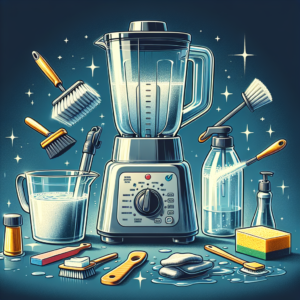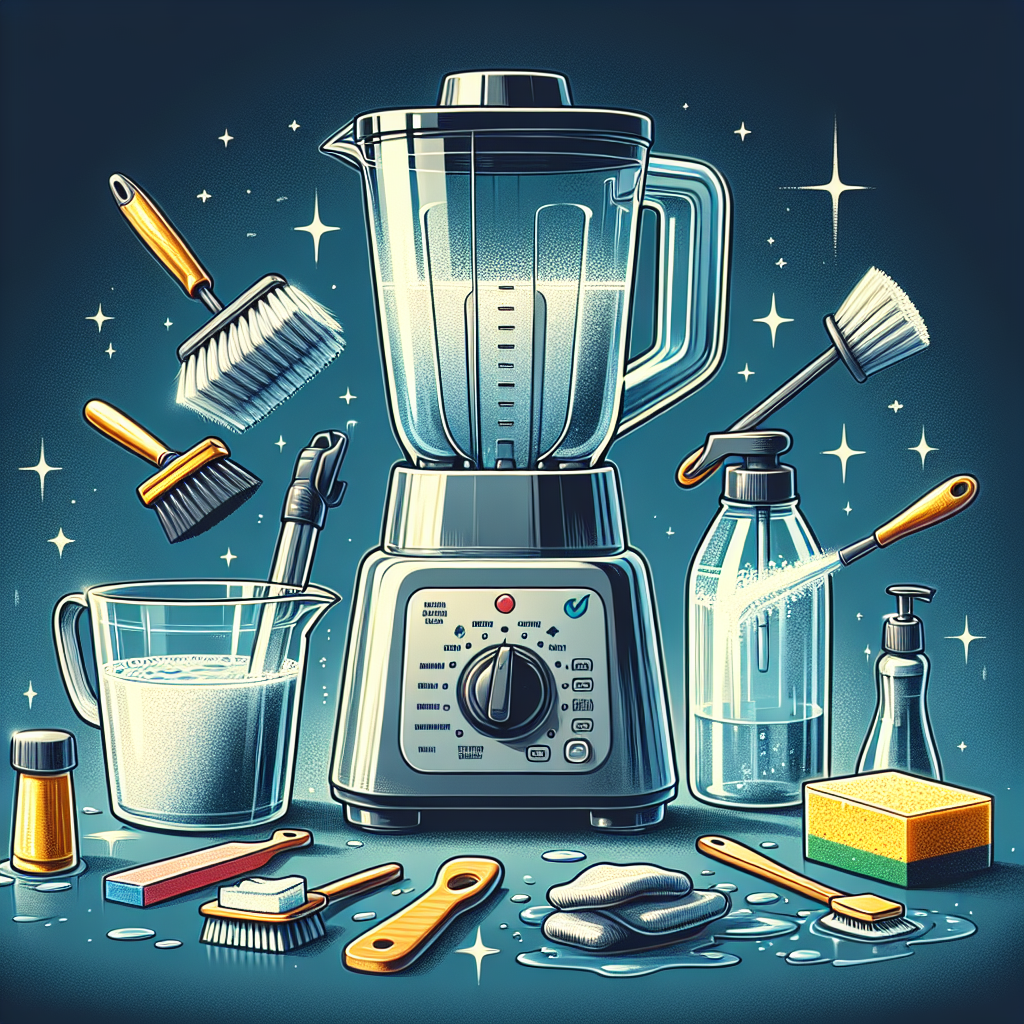How Do I Clean And Care For A Blender With A Glass Pitcher?
November 20, 2023

Hey there! Have you ever wondered how to keep your blender with a glass pitcher sparkling clean and in tip-top shape? Look no further, because we’ve got you covered! In this article, we’ll guide you through some simple and effective tips on how to clean and care for your blender. Say goodbye to stubborn stains and unpleasant odors – with just a few easy steps, your blender will be as good as new in no time. Let’s get started! Cleaning the blender:
Cleaning your blender is an important step in maintaining its functionality and ensuring its longevity. By regularly cleaning the different parts of your blender, you can remove any residue, stains, or odors that may build up over time. In this article, we will guide you through the process of cleaning each component of your blender: the pitcher, the lid, the blades, and the base.
Cleaning the pitcher:
To clean the glass pitcher of your blender, start by removing it from the base and emptying out any remaining liquid or ingredients. Then, fill the pitcher halfway with warm water and add a few drops of dish soap. Swirl the soapy water around in the pitcher, making sure to reach all the corners, and scrub gently with a sponge or brush. Rinse the pitcher thoroughly with warm water to remove any soap residue. To dry the pitcher, place it upside down on a clean towel or dish rack.
Cleaning the lid:
Next, it’s time to clean the lid of your blender. Begin by removing any detachable parts, such as the center cap or the measuring cup. Wash these parts separately with warm water and dish soap. For the main lid, rinse it under warm water to remove any loose debris. Then, use a sponge or cloth to gently scrub the lid with dish soap, paying attention to any crevices or hard-to-reach areas. Rinse the lid thoroughly to remove all soap residue and allow it to air dry.
Cleaning the blades:
The blades of your blender can collect residue from various ingredients, so it’s essential to clean them properly. Begin by unplugging your blender to ensure safety. Carefully remove the pitcher from the base, being mindful of the sharp blades. Fill the sink or a large bowl with warm, soapy water and place the blades inside. Allow them to soak for about 10-15 minutes, which will help loosen any tough residue. After soaking, use a soft brush or sponge to scrub the blades gently, paying close attention to the areas between the blades. Rinse the blades thoroughly under warm water and dry them with a clean cloth before reassembling the blender.
Cleaning the base:
The base of your blender is where the motor and control buttons are located, and it’s important to keep it clean to maintain its performance. Start by unplugging the blender from the power source. Use a slightly damp cloth or sponge to wipe down the exterior of the base, removing any dust, dirt, or spills. Be cautious not to get any water or liquid inside the base to avoid damaging the electrical components. Dry the base thoroughly with a clean cloth, ensuring it’s completely dry before plugging in the blender again.
Removing tough stains:
Over time, your blender pitcher may develop tough stains that are challenging to remove. Fortunately, there are several natural and effective methods you can use to tackle these stubborn stains.
Using baking soda:
Baking soda is a versatile cleaning agent that can help remove stains from your blender pitcher. Start by filling the pitcher halfway with warm water and adding two tablespoons of baking soda. Stir the mixture gently to dissolve the baking soda. Let the solution sit for about 30 minutes, allowing the baking soda to work its magic on the stains. Afterward, scrub the pitcher with a sponge or brush, paying extra attention to the stained areas. Rinse the pitcher thoroughly with warm water to remove any remaining baking soda residue.
Using vinegar:
Vinegar is another excellent natural cleaner that can effectively remove tough stains from your blender’s glass pitcher. Create a solution by mixing equal parts of vinegar and water in the pitcher, filling it about halfway. Let the solution sit for approximately 30 minutes to allow the vinegar’s acidity to break down the stains. Afterward, use a sponge or brush to scrub the pitcher, focusing on the stained areas. Rinse the pitcher thoroughly with warm water to remove any vinegar residue and odor.
Using lemon juice:
Lemon juice is not only a natural stain remover but also leaves a refreshing scent behind. Squeeze the juice of one or two lemons into your blender pitcher, filling it about halfway. Let the lemon juice sit on the stains for approximately 15-30 minutes. Then, use a sponge or brush to scrub the pitcher, paying extra attention to stubborn stains. Rinse the pitcher thoroughly with warm water to remove any lemon residue.
Caring for the glass pitcher:
While cleaning your blender pitcher is essential, taking proper care of it on a daily basis can help prevent issues and prolong its lifespan. Here are some tips for caring for your glass pitcher:
Avoiding sudden temperature changes:
Glass pitchers can be sensitive to sudden temperature changes, which may cause them to crack or shatter. To avoid this, allow hot ingredients to cool slightly before blending them. Similarly, avoid pouring cold liquids into a hot pitcher. Gradual temperature changes are less likely to damage the glass.
Handling the pitcher with care:
Glass is fragile, so it’s crucial to handle your blender pitcher with care. Always hold the pitcher by the handle, avoiding excessive force or twisting motions that could lead to a crack or break. When inserting or removing the pitcher from the base, do so gently and avoid any unnecessary jostling or dropping.
Storing the pitcher properly:
To prevent accidental damage, store your blender pitcher in a safe and secure location. Ensure there are no heavy objects or other items that could fall on or bump into the pitcher, potentially causing it to break. Store the pitcher upright in a cabinet or on a shelf, away from any high-traffic areas.
Maintaining the blender:
In addition to cleaning and caring for the individual parts of your blender, there are a few general maintenance tips you should keep in mind to ensure its optimal performance.
Regularly cleaning the blender:
Cleaning your blender regularly, as mentioned previously, is crucial for its long-term functionality. By removing residue or buildup, you can avoid potential issues such as a sticky blade assembly or ineffective blending. Make a habit of cleaning the blender after each use or, at the very least, before storing it for an extended period.
Replacing worn parts:
Over time, the blades, gaskets, or other components of your blender may wear down or become damaged. It’s important to periodically check these parts for any signs of wear and tear. If you notice any issues, such as dull blades or leaks, consider replacing the worn parts to maintain the blender’s performance and prevent further damage.
Properly assembling the blender:
When reassembling your blender after cleaning or replacing parts, ensure that all components are properly aligned and securely fitted. Double-check that the pitcher is sitting correctly on the base, and the lid is securely in place. Failing to assemble the blender correctly may lead to operational problems or potential accidents.
By following these cleaning and care tips, you can keep your blender with a glass pitcher in excellent condition for years to come. Regularly cleaning each component, removing tough stains using natural cleaners, and caring for the glass pitcher will help maintain its performance and prolong its lifespan. Additionally, taking proper care of the blender as a whole, including regularly cleaning it, replacing worn parts, and properly assembling it, will ensure that you can enjoy perfectly blended concoctions whenever you need them.

